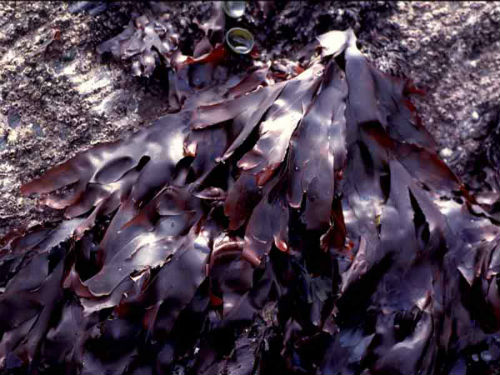Nova Scotia Dulse is a red seaweed grown in the northern atlantic and pacific northwest. California, Nova Scotia, Spain, Ireland, and Maine are fertile areas where the plant is grown. It’s also called dulse for short, and its scientific name is Palmaria Palmata.
Nova Scotia Dulse as a Medicinal Food
Edible seaweed has a long history of use in different Asian cultures. It’s easy to harvest and the plant has been around for thousands of years in its current form. There are records suggesting Japanese cultures began cultivating red seaweed as far back as 300 years ago. Edible seaweed like Dulse, kelp, and others gained attention from researchers in the 1990’s when it was discovered that many Asian populations that were notable for long lifespans and lack of chronic diseases used sea vegetables more frequently in their diet than westerners.
Dulse is particularly prevalent in arctic waters, and it’s believed it spread from the arctic circle into Ireland, Spain, and Novia Scotia about 20,000 years ago after the last ice age.
Overall, dulse and other sea vegetables are notable for their high mineral and protein content, particularly iron and potassium. At its highest levels of concentration Dulse has 34 times as much potassium as a banana. Not too shabby.
Dulse Mineral Content
Dulse has an unusually high concentration of different minerals. One study found a total of 112 different minerals and trace elements in a collection of red seaweed from northern Spain. Minerals with the highest concentrations are copper, zinc, potassium, calcium, and magnesium. One study found that dulse had potassium concentrations 34 times higher than a banana. In fact, the potassium content was so high that it’s advised patients with renal conditions consult a doctor or dietician before using dulse in your diet.
Fatty Acid Content
For a vegetable, dulse has an unusually large amount of poly-unsaturated fatty acids. Moreso than green seaweeds. Furthermore, dulse has an unusually high concentration of EPA and DHA, which are omega-3 fatty acids most commonly found in fish. The ratio of n-6/n3 fatty acids in dulse is close to 1, which is believed to be optimal.
A variety of studies suggest that edible seaweeds (including dulse) have strong anti-oxidative properties that prevent unhealthy cell proliferation. In Nova Scotia Dulse, these properties are believed to be caused by its high poly-phenol content. A study published in the Journal of Food Chemistry and Toxicology found that Palmaria Palmata (Nova Scotia Dulse) had the highest polyphenol content and the strongest inhibitory effects on cell proliferation in a group of red and green seaweeds. These properties have caused Nova Scotia Dulse and other seaweeds to be studied closely by cancer researchers and edible seaweed is increasingly being used as a “Functional Food” in anti-carcinogenic products.
Caveats
The variability of nutritional value in dulse is very high. The location, season, and mineral content of the water it resides in has a large impact on its mineral and polyphenol profile. For example, a study conducted in the Journal of Nutritional Biochemistry found that the protein content in Dulse was twice as high in the winter than in the summer. Exposure to sun and UV rays can have a significant effect on the vitamin and mineral content in Dulse since sunlight can damage parts of the algal cell.
Dulse has a high protein content for a vegetable, but it’s not absorbed very well. In an unusual twist, protein absorption increases after manufacturing because absorption is inhibited by non-soluble fibers that bind to the protein in its natural state but are broken up when being processed.
Also, compared to other foods, the overall level of research on red seaweed in general and dulse in particular is small. More common ingredients like spinach, broccoli, and garlic have been studied much more extensively. Furthermore, there’s not a lot of research that analyzes the changes in nutritional value of dulse throughout the manufacturing process and how different brands, manufacturing processes, or growing conditions might affect the types of dulse you buy in food products.
So we have these experiments that show dulse helps slow down cell growth or promotes this condition in a laboratory setting, but there’s no consensus on how much of these benefits are kept when we take a dulse supplement, eat seaweed chips, or use other similar products.
Conclusion
The purported health benefits of Dulse more or less ring true. Its fatty acid, mineral, and polyphenol composition make it unique. For vegetarians especially its a remarkable source of different nutrients that are hard to find elsewhere, even in nutritional behemoths like spinach or broccoli.
Sources
van Ginneken VJ, Helsper JP, de Visser W, van Keulen H, Brandenburg WA. Polyunsaturated fatty acids in various macroalgal species from North Atlantic and tropical seas. Lipids Health Dis. 2011 Jun 22;10:104
Lordan S, Ross RP, Stanton C. Marine bioactives as functional food ingredients: potential to reduce the incidence of chronic diseases. Mar Drugs. 2011;9(6):1056-100
Romarís-Hortas V, García-Sartal C, Barciela-Alonso MC, Moreda-Piñeiro A, Bermejo-Barrera P.Characterization of edible seaweed harvested on the Galician coast (northwestern Spain) using pattern recognition techniques and major and trace element data. J Agric Food Chem. 2010 Feb 10;58(3):1986-92
Yuan YV, Walsh NA. Antioxidant and antiproliferative activities of extracts from a variety of edible seaweeds. Food Chem Toxicol. 2006 Jul;44(7):1144-50
Yuan YV, Carrington MF, Walsh NA. Extracts from dulse (Palmaria palmata) are effective antioxidants and inhibitors of cell proliferation in vitro. Food Chem Toxicol. 2005 Jul;43(7):1073-81
Provan J, Wattier RA, Maggs CA. Phylogeographic analysis of the red seaweed Palmaria palmata reveals a Pleistocene marine glacial refugium in the English Channel. Mol Ecol. 2005 Mar;14(3):793-803.
Holzinger A, Lütz C, Karsten U, Wiencke C. The effect of ultraviolet radiation on ultrastructure and photosynthesis in the red macroalgae Palmaria palmata and Odonthalia dentata from Arctic waters. Plant Biol (Stuttg). 2004 Sep;6(5):568-77.
Marrion O, Schwertz A, Fleurence J, Guéant JL, Villaume C. Improvement of the digestibility of the proteins of the red alga Palmaria palmata by physical processes and fermentation.Nahrung. 2003 Oct;47(5):339-44.
Galland-Irmouli AV, Fleurence J, Lamghari R, Luçon M, Rouxel C, Barbaroux O, Bronowicki JP, Villaume C, Guéant JL. Nutritional value of proteins from edible seaweed Palmaria palmata (dulse). J Nutr Biochem. 1999 Jun;10(6):353-9.



My wife is very into natural health and she’s reading a lot about seaweed right now. I actually referenced her to this blog after reading your post about the Okinawans. I don’t mind the taste of it but so far it’s hard to find it at restaurants. The only place I can seem to buy it is at expensive health stores, but we stay away from those for budget reasons. (Gotta watch the wallet in this economy)
LikeLike
I think seaweed is great for you, even though it is expensive. It is also hard to find. If I can get my hands on some that would be good. 🙂
LikeLike
I buy my organic dulse powder on line from http://www.znaturalfoods.com
LikeLike
Hi The best dulse I have ever eaten is from Parrsboro Nova Scotia. My Mothers hometown. Its a fairly good size bag for $30.50.Love it!
LikeLike
Mistake the above cost is three dollars and fifty cents
LikeLike
@Tom,Personally, I like the taste of seaweed as well. In soups and salads, I think it’s a nice compliment to dishes. Much better than broccoli or spinach, which just don’t have the mouth feel to make it palatable.
LikeLike
[…] is my favorite, especially dulse that comes from Nova Scotia. I have written previously about the health benefits of Nova Scotia Dulse.Herbs/Berries/Extracts: It gets complicated here due to sheer volume and diversity, but here are my […]
LikeLike
[…] a mixture.But overall, these ingredients are excellent. I’ve written previously about the health benefits of dulse and acerola, and many of the other ingredients are some my favorites that I wrote about in my […]
LikeLike
[…] Leaf, Carob Pod, Shilajit, Amla BerryAlgaes: spirulina, chlorellaSeaweeds: kelp, nori, dulse, alaria, bladderwrack, laverEnzymes: protease, amylase, lipase, cellulase, bromelain, papain, […]
LikeLike
People right so much without saying anything. One chart with nutritional info would be appreciated
LikeLike
If you must attack people’s intelligence, you should probably mind your own grammer when doing so. Am I right or should I say write?
LikeLike
[…] Red Dulse. A nutritionally potent fresh water seaweed. […]
LikeLike
What about all the radiation from Japan? You have to be careful about this as alot of our seafood is now radiated!
LikeLike
Nova Scotia dulse is VERY unlikely to be irradiated — it’s more than 5,000km away from West Coast, on East side of continent
LikeLike
You can grind it up and season your soups, etc…that way. Here in Parrsboro, NS we call that dulse flakes and is has been found alongside the salt & pepper shakers at local restaurants here. My husband’s and my favorite is to sprinkle on caesar salad – yummy 🙂
LikeLike
I would like to know of it is O K to eat dulse when you have gout problems? . I like it and eat it in small amounts to boost my iron intake.
LikeLike
Dilys,
As far as I know then yes it should be fine.
LikeLike
I read through the article and NOT ONE mention of iodine. Is there any iodine in dulse? Also, I live in Ontario, and have friends down East. They sent me dulse from Maine, US. I wondered why, and answer was — the Canadian Coast is polluted, and there are signs at the beaches
not to consume anything from the ocean. Could someone clarify this?
LikeLike
How about using Dulse if you have had a history of kidney stones, would Nova Scotia Dulse cause more Stones, I noticed in an article Dulse may cause problems for people with renal conditions.
LikeLike
Robert,
I doubt that dulse would cause many problems for most people, although of course it’s possible there could be some complications.
If you have questions about kidney stones I suggest you read my article on the topic: https://blog.healthkismet.com/naturally-treating-gout-how-to-separate-myth-from-reality
LikeLike
My mom is on a Reno diet and she is not allowed to have dulse
LikeLike
If you go to any local fishing village in NS and ask who harvest dulse, they can tell you and it is super cheep!
LikeLike
http://www.seaveg.com/shop/index.php?main_page=page&id=15&chapter=1
LikeLike
If you take levothyroxine for hypothyroidism can you also eat dulse ?
LikeLike
[…] Nova Scotia Dulse: Health Benefits, Facts, … – Nova Scotia Dulse as a Medicinal Food. Edible seaweed has a long history of use in different Asian cultures. It’s easy to harvest and the plant has been around for … […]
LikeLike
[…] Nova Scotia Dulse: Health Benefits, Facts, … – Nova Scotia Dulse is a red seaweed grown in the northern atlantic and pacific northwest. California, Nova Scotia, Spain, Ireland, and Maine are fertile areas where … […]
LikeLike
for a quality source of dulse visit our website at dulseadventure.com
LikeLike
[…] European cuisines. It has many health benefits. Novia Scotia Dulse is a type of seaweed with many health benefits used in Asian cultures. Unfortunately though, these ingredients appear at the end of the […]
LikeLike
from Rick,been fighting cancer for 3 years now and I need to get my system back on track, I have done A lot of reading about greens of all sorts I am on 100% disability U know where I can get enexpensive greens
LikeLike
[…] Sources: http://wellnessmama.com/8592/horsetail-herb-profile/ http://foodfacts.mercola.com/rosemary.html http://healthyeating.sfgate.com/sage-herb-health-benefits-5426.html https://blog.healthkismet.com/nova-scotia-dulse-health-benefits-facts-and-m […]
LikeLike
If you eat too much dulse , it will lower your blood pressure as I found out after eating it for a few days. Felt lightheaded and sluggish and BP check systolic was 16 points lower than usual.
LikeLike